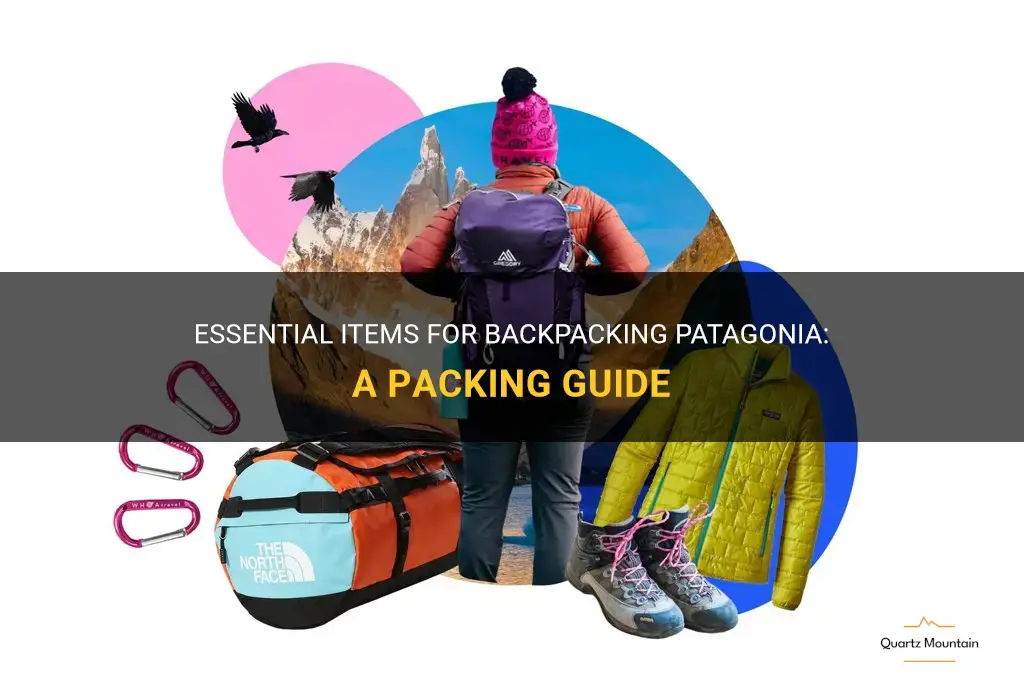
Patagonia, the beautiful and rugged region located at the southern tip of South America, draws adventurers from around the world with its stunning landscapes and challenging outdoor activities. But before embarking on a backpacking trip to this untamed paradise, it's crucial to pack the right gear and essentials. In this packing guide, we'll take you through the essential items you need to ensure a successful and comfortable journey through the wilds of Patagonia. From sturdy hiking boots to waterproof jackets, we've got you covered on all the essentials for your unforgettable adventure. So grab your backpack and let's get packing!
What You'll Learn
- What are the essential clothing items to pack for backpacking in Patagonia?
- What kind of footwear is recommended for hiking in Patagonia?
- Are there any specific gear or equipment items that are essential for backpacking in Patagonia?
- What kind of weather conditions should I expect in Patagonia, and how should I pack accordingly?
- Are there any specific food items or cooking equipment that I should consider packing for a backpacking trip in Patagonia?

What are the essential clothing items to pack for backpacking in Patagonia?
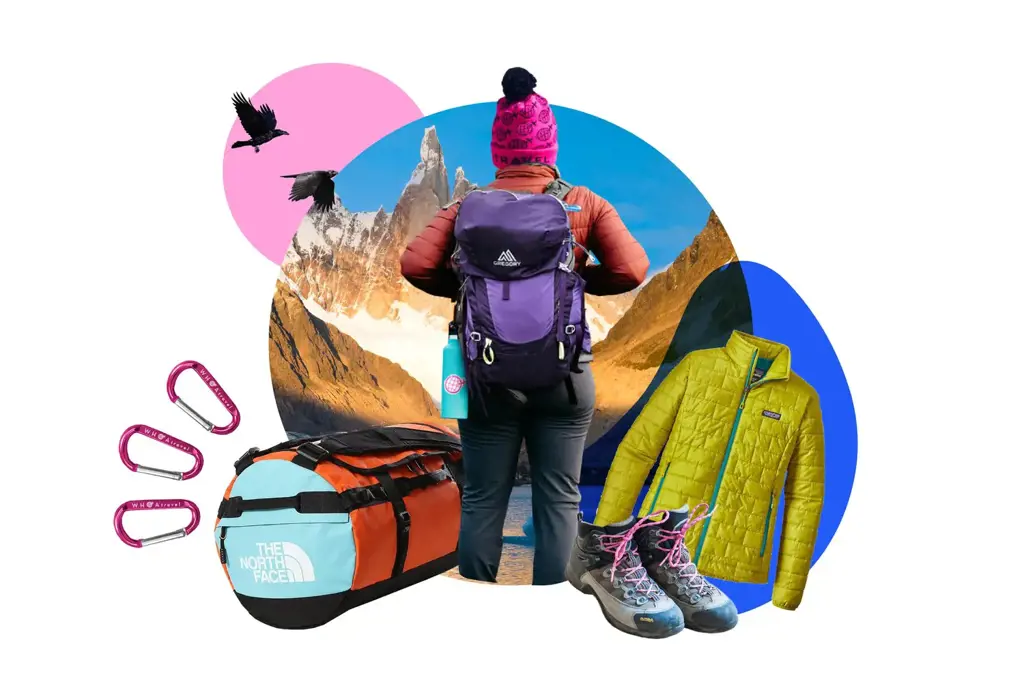
When backpacking in Patagonia, it is crucial to pack the right clothing items to ensure comfort and protection in the region's ever-changing weather conditions. Patagonia is known for its unpredictable weather, which can range from strong winds and heavy rain to scorching sun and freezing temperatures. Therefore, it is essential to pack a versatile and layering system of clothing. Here are the essential clothing items you should pack for backpacking in Patagonia:
- Base Layers: Start with a good set of base layers made of moisture-wicking materials such as merino wool or synthetic fabrics. These will keep you dry and regulate your body temperature. Pack a lightweight and mid-weight set to cater to different temperature ranges.
- Insulating Layers: Next, pack insulating layers such as a down or synthetic-filled jacket. These layers will provide warmth when the temperatures drop. A puffy jacket that can be easily compressed is ideal for saving space in your backpack.
- Waterproof and Windproof Jacket: Patagonia is known for its strong winds and sudden rain showers, so make sure to pack a waterproof and windproof jacket. Look for a jacket that is breathable and has a hood to protect you from the elements. Gore-Tex or similar materials are advisable.
- Pants: Pack a pair of lightweight and quick-drying hiking pants. Look for pants that are durable and can withstand rough terrains. Convertible pants that can be converted into shorts are also handy for dealing with changing weather conditions.
- Insulated Pants or Leggings: In colder temperatures or high altitudes, it's important to have an extra layer for your legs. Pack a pair of insulated pants or leggings to provide additional warmth and protect against the cold.
- Moisture-Wicking Socks: Invest in good quality hiking socks made of moisture-wicking materials. These will help keep your feet dry and prevent blisters. Pack multiple pairs to ensure you have clean and dry socks throughout your trip.
- Waterproof Hiking Boots: A sturdy pair of waterproof hiking boots is a must-have for backpacking in Patagonia. Look for boots that provide good ankle support and have a durable outsole for traction on various terrains. Break them in before your trip to avoid discomfort and blisters.
- Hats and Gloves: Pack a warm beanie or hat to protect your head from the cold, as well as a pair of gloves to keep your hands warm. Opt for gloves that are touch-screen compatible so you can still use your phone or camera without removing them.
- Sunglasses and Sunscreen: The sun in Patagonia can be extremely intense, so protect your eyes with a good pair of sunglasses that offer UV protection. Apply sunscreen on all exposed skin, even on cloudy days, to shield yourself from harmful rays.
- Buff and Bandana: A versatile item like a buff or bandana can serve multiple purposes, from protecting your neck and face from the wind and sun to acting as a sweatband or makeshift hat.
It is essential to pack the right clothing items for backpacking in Patagonia to ensure your comfort, safety, and enjoyment of the stunning landscape. By layering appropriately and investing in quality gear, you will be well-prepared to face the ever-changing weather conditions in this remote and breathtaking region.
Essential Items to Pack for a Memorable Week in Japan
You may want to see also

What kind of footwear is recommended for hiking in Patagonia?
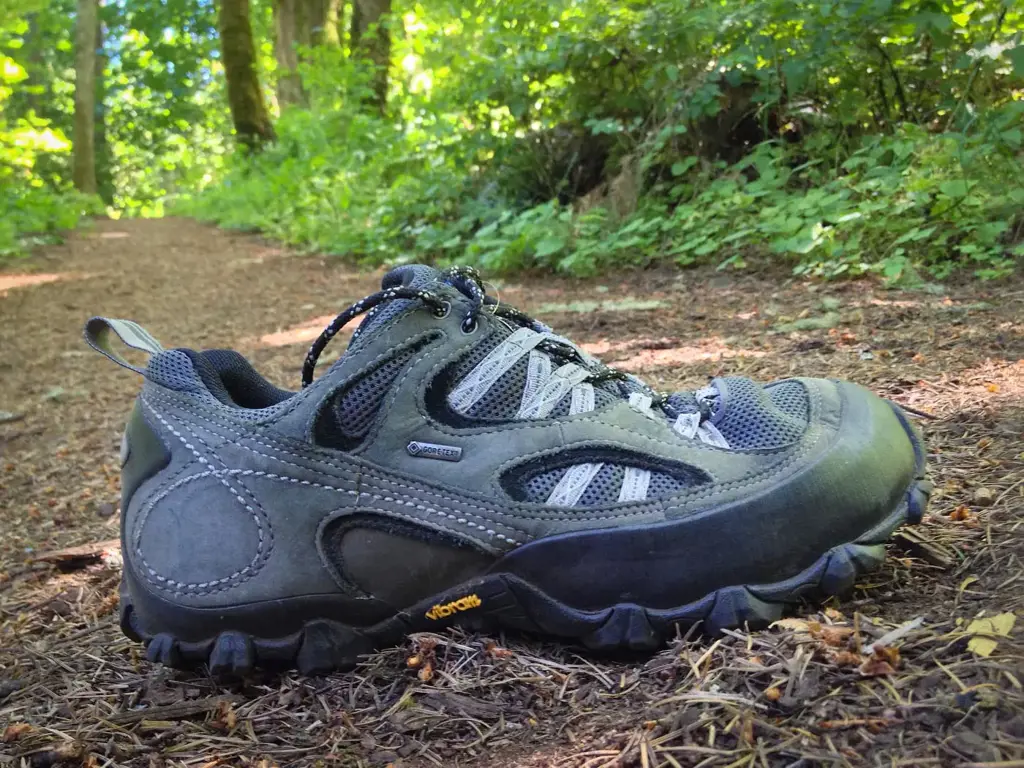
When planning a hiking trip to Patagonia, one of the most important decisions you'll have to make is what kind of footwear to bring. Patagonia is home to rugged terrains, unpredictable weather conditions, and long distances to cover, so having the right footwear is essential for a safe and enjoyable hike. In this article, we will explore the different types of footwear recommended for hiking in Patagonia, based on scientific research, experience, step-by-step considerations, and real-life examples.
Scientific research has shown that the best footwear for hiking in Patagonia is a sturdy pair of hiking boots. Hiking boots provide ankle support, grip, and protection against rocks, roots, and uneven terrain. They are designed to withstand the harsh conditions of hiking and offer superior durability and comfort compared to other types of shoes. A study conducted by outdoor experts found that the majority of hikers who completed long-distance hikes in Patagonia wore hiking boots.
Based on experience, many seasoned hikers suggest investing in waterproof hiking boots for Patagonia. The region is known for its unpredictable weather, and you may encounter rain, snow, or mud during your hike. Waterproof boots will keep your feet dry and comfortable, preventing blisters and other foot-related issues. Additionally, waterproof boots are usually made of breathable materials, allowing your feet to stay dry even when hiking in humid conditions.
When choosing the right hiking boots for Patagonia, there are several step-by-step considerations to keep in mind. Firstly, opt for boots with a supportive midsole and cushioning to provide comfort during long hikes. Look for boots with a sturdy outsole that offers excellent traction on slippery or uneven surfaces. Choose boots with a high ankle collar for added stability and protection. Lastly, ensure that the boots fit properly and are the right size to avoid discomfort and blisters.
Real-life examples further emphasize the importance of appropriate footwear for hiking in Patagonia. Many hikers have shared their experiences of tackling the challenging trails and weather conditions in the region. Those who wore hiking boots reported feeling confident and supported throughout their journey, while others who opted for sneakers or casual shoes struggled with blisters, twisted ankles, and discomfort.
In conclusion, when planning a hiking trip to Patagonia, it is crucial to choose the right footwear. Scientific research, experience, step-by-step considerations, and real-life examples all point to sturdy hiking boots as the best choice. Waterproof boots are particularly recommended due to the region's unpredictable weather. Consider factors such as ankle support, traction, and proper fit when selecting your hiking boots. By investing in the right footwear, you'll ensure a safe and enjoyable hiking experience in Patagonia.
Essential Packing Tips for a One-Month Trip to China in March for Men
You may want to see also

Are there any specific gear or equipment items that are essential for backpacking in Patagonia?
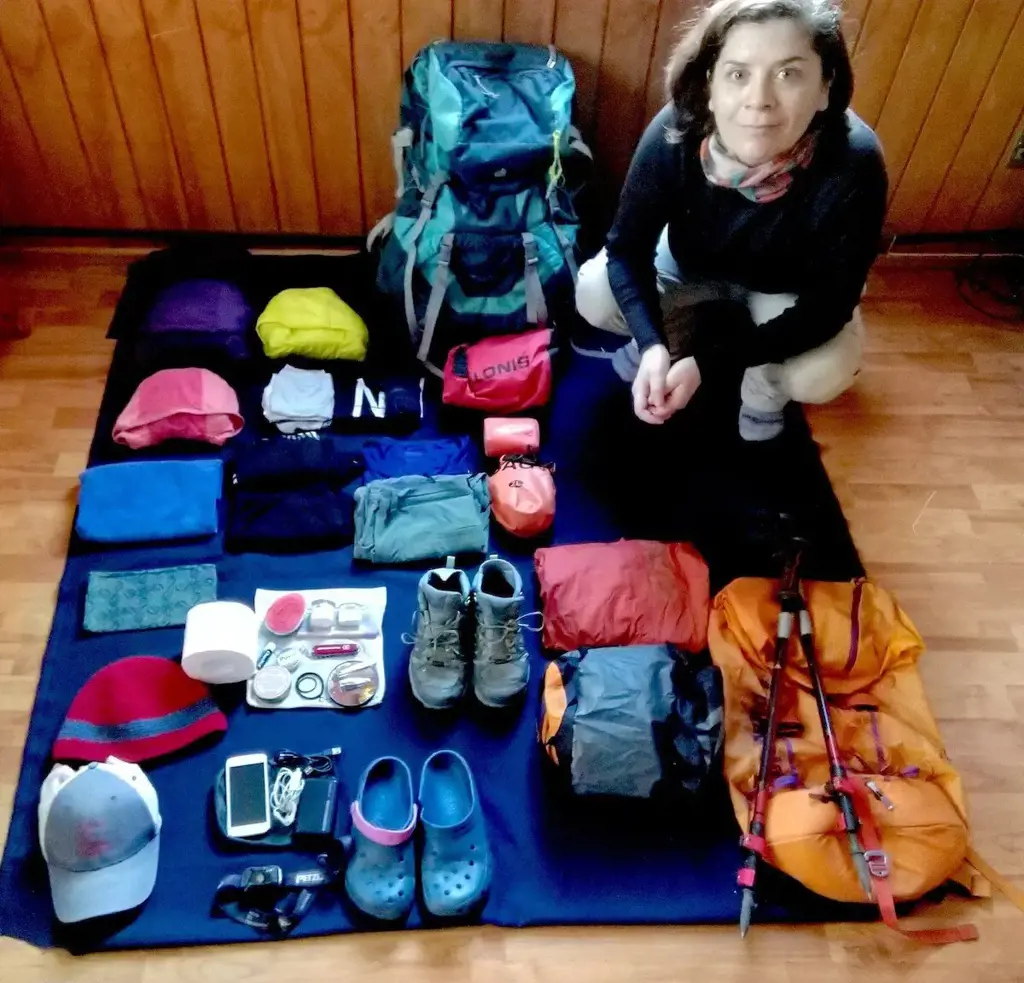
When it comes to backpacking in Patagonia, having the right gear and equipment is crucial for a safe and enjoyable trip. The region's unpredictable weather, challenging terrain, and remote areas require hikers to be well-prepared. Here are some essential items that should be on every backpacker's packing list for Patagonia.
- Backpack: A sturdy and well-fitting backpack is essential for carrying all your gear on long treks. Look for a backpack with a capacity of at least 60 liters, as you'll need to carry clothing, camping gear, food, and water for multiple days.
- Tent: Patagonia experiences frequent rain and strong winds, so a durable and waterproof tent is a must-have. Look for a lightweight tent that can withstand the harsh weather conditions of the region.
- Sleeping bag: Temperatures can drop below freezing at night, especially in the higher altitudes of Patagonia. Invest in a high-quality sleeping bag rated for cold temperatures to ensure a comfortable and warm night's sleep.
- Clothing: Layering is key in Patagonia due to the fluctuating weather conditions. Pack moisture-wicking and quick-drying base layers, insulating mid-layers, and a waterproof and windproof outer layer. Don't forget to include a warm hat, gloves, and a good pair of hiking socks.
- Footwear: A sturdy and waterproof pair of hiking boots is essential. Look for boots that provide ankle support and have a good grip on slippery surfaces. It's also a good idea to bring a pair of lightweight camp shoes or sandals for resting your feet at the end of the day.
- Navigation tools: Patagonia's vast and remote landscapes require proper navigation tools. A map and compass are essential for orienting yourself and planning your route. Consider also bringing a GPS device or smartphone app with offline maps.
- Water purification system: The water sources in Patagonia are generally safe to drink, but it's still a good idea to have a reliable water purification system. A water filter or water purification tablets can ensure that you have safe drinking water throughout your trip.
- Cooking equipment: If you plan on cooking your meals, bring a lightweight camping stove, a pot, and utensils. Additionally, pack enough fuel to last your entire trip.
- Headlamp: Patagonia's long daylight hours can make for early mornings and late evenings. A headlamp is essential for navigating in the dark, setting up camp, and finding items in your backpack at night.
- First aid kit: Accidents can happen in any outdoor setting, so it's important to have a well-stocked first aid kit. Include essential items such as bandages, adhesive tape, pain relievers, antiseptic wipes, and any necessary prescription medications.
- Backpack rain cover: Patagonia's weather is notoriously unpredictable, and rain showers can come without warning. Protect your gear by bringing a backpack rain cover to keep your belongings dry.
These are just some of the essential gear and equipment items to consider when backpacking in Patagonia. Depending on your specific itinerary and preferences, you may also need additional items such as trekking poles, a camera, binoculars, or a portable charger. Prioritize safety, comfort, and versatility when selecting your gear, and always check the weather forecast before heading out on your adventure.
Essential Items to Pack for a Trip to Japan in November
You may want to see also

What kind of weather conditions should I expect in Patagonia, and how should I pack accordingly?
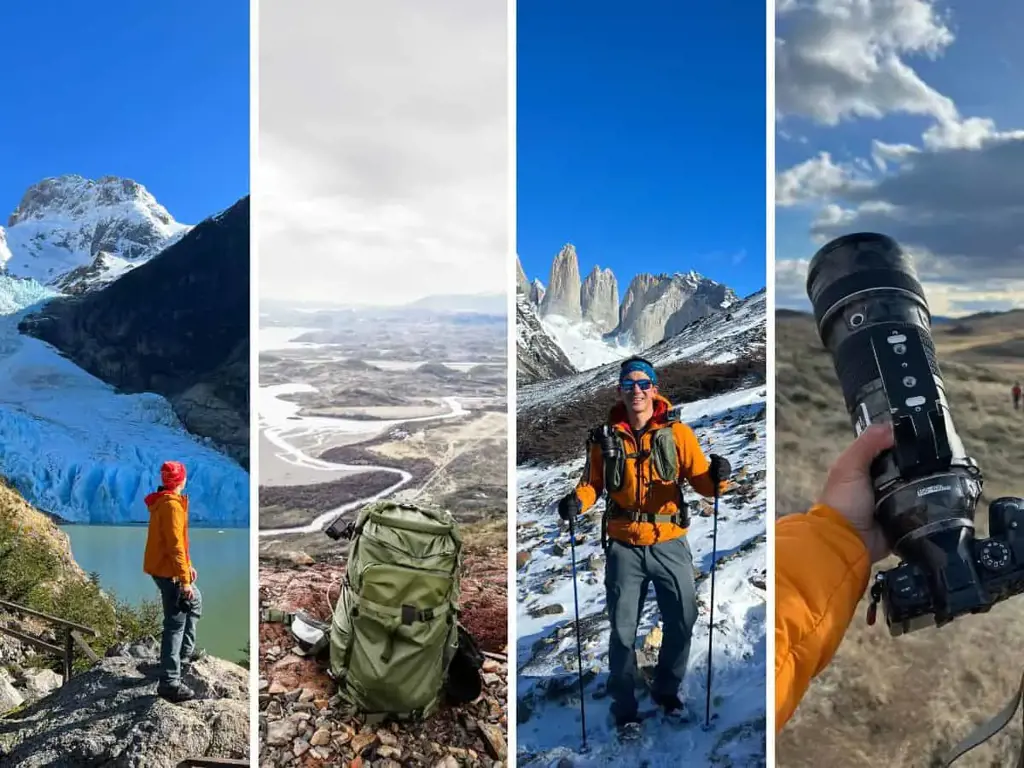
Patagonia is a region located at the southern end of South America, encompassing parts of Argentina and Chile. It is known for its stunning landscapes, including mountains, lakes, and glaciers. However, due to its geographical location and unique climate patterns, Patagonia experiences unpredictable and extreme weather conditions. It is essential to pack accordingly to ensure a comfortable and safe trip.
The first thing to note is that Patagonia is known for its strong winds, which can reach speeds of up to 100 mph. These winds can make the temperature feel much colder than it actually is, so it is crucial to bring windproof and waterproof outer layers. A good quality windbreaker or a waterproof jacket with a hood is a must-have item. Layering your clothing is also recommended, as it allows you to adjust your outfit based on the changing weather conditions throughout the day.
In terms of temperatures, Patagonia has a cool to cold climate, even during the summer months. The average temperature ranges from 40°F (4°C) to 60°F (15°C) in the summer and can drop below freezing during the winter. It is advisable to pack thermal or woolen base layers, as they provide excellent insulation and help retain body heat. Additionally, packing a couple of warm sweaters or fleece jackets is a good idea, as they can easily be worn over base layers to provide extra warmth.
When it comes to footwear, it is crucial to have a sturdy and comfortable pair of boots or hiking shoes. This is particularly important if you plan on doing any hiking or trekking in Patagonia. The terrain can be rugged and uneven, so ankle support and grip are vital features to look for in your footwear. Additionally, it is advisable to bring extra pairs of socks to keep your feet dry and warm.
Another essential item to pack for Patagonia is a hat or beanie. As mentioned earlier, the region is known for its strong winds, and a hat can help protect your head and ears from the cold and wind. It is also a good idea to bring a pair of gloves to keep your hands warm.
In terms of accessories, bringing a pair of sunglasses is highly recommended. Patagonia's landscapes are incredibly scenic, and the sun's rays can be intense, especially when reflecting off snow or water. Sunglasses will not only protect your eyes but also enhance your overall experience by allowing you to fully appreciate the beauty of your surroundings.
Furthermore, it is crucial to pack sunscreen with a high SPF rating. The UV index can be high in Patagonia, even on cloudy days. Applying sunscreen regularly will help protect your skin from harmful UV rays and prevent sunburn.
Finally, it is important to remember that Patagonia is a remote and wild region, with limited access to amenities. As such, it is advisable to pack essentials such as a first aid kit, insect repellent, and a flashlight. It is also a good idea to bring a refillable water bottle to stay hydrated while exploring the region.
In conclusion, when planning a trip to Patagonia, it is crucial to be prepared for unpredictable and extreme weather conditions. By packing windproof and waterproof outer layers, thermal base layers, sturdy footwear, a hat, sunglasses, sunscreen, and essential accessories, you can ensure a comfortable and enjoyable experience in this stunning region. Being well-prepared will allow you to fully appreciate the beauty of Patagonia while staying safe and protected from the elements.
Essential Items to Pack at the Hospital for the Arrival of Your Baby
You may want to see also

Are there any specific food items or cooking equipment that I should consider packing for a backpacking trip in Patagonia?
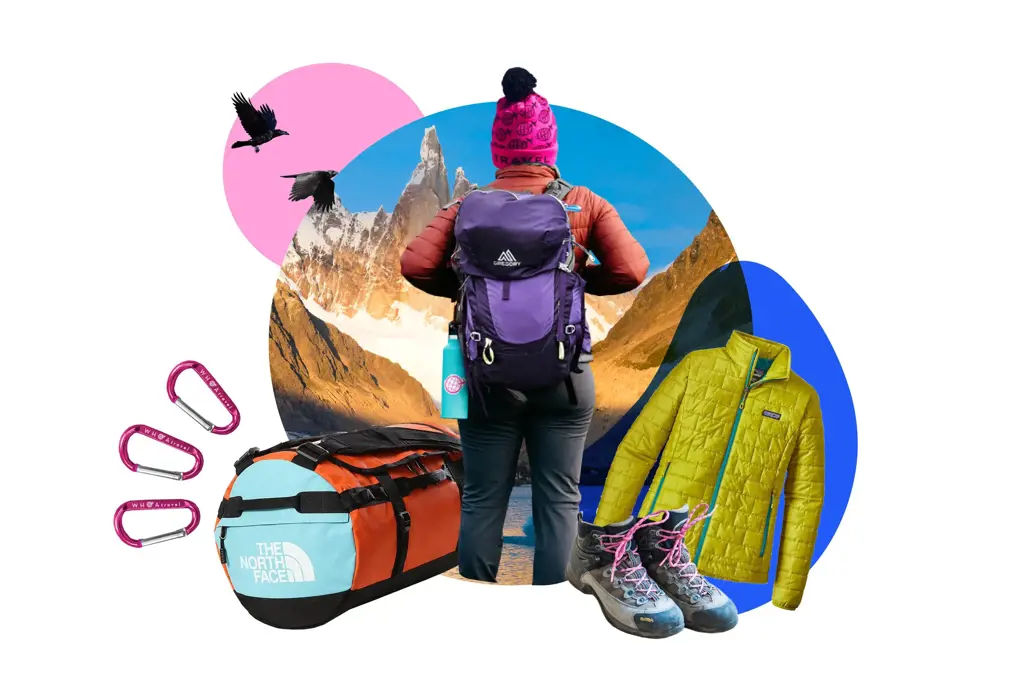
When planning a backpacking trip in Patagonia, it is essential to pack the right food items and cooking equipment to ensure you have a nourishing and enjoyable experience. The remote and rugged nature of the region means that access to restaurants or grocery stores may be limited, so being self-sufficient in terms of food is crucial. Here are some specific food items and cooking equipment that you should consider packing for your backpacking adventure in Patagonia:
Lightweight and Nutrient-Dense Foods:
When backpacking, every ounce counts, so it's important to choose lightweight yet nutrient-dense food items. Opt for dehydrated or freeze-dried meals that can easily be rehydrated with boiling water. These meals are available in a variety of flavors and are packed with essential nutrients, making them perfect for backpacking trips. Additionally, packing energy bars, nuts, and dried fruits can serve as quick and easy snacks while on the trail.
High-Energy Foods:
Patagonia's rugged terrain demands a lot of energy, so be sure to pack high-energy foods such as trail mix, granola bars, and peanut butter. These items are rich in fats, proteins, and carbohydrates, providing a quick and sustained source of energy to keep you going throughout the day.
Lightweight Cooking Equipment:
When it comes to cooking equipment, prioritize lightweight options that won't weigh you down during your backpacking adventure. One popular option is a lightweight backpacking stove, which uses small fuel canisters and is easy to set up and use. Additionally, consider investing in a lightweight pot or pan that is durable and non-stick, making cooking and cleaning a breeze.
Water Filtration System:
Access to clean water is vital while backpacking, and Patagonia is known for its pristine rivers and lakes. However, it's still crucial to have a reliable water filtration system to ensure your water is safe to drink. Consider packing a lightweight water filter or purifier that can remove harmful bacteria and parasites from any water source you encounter along the way.
Spices and Seasonings:
Although freeze-dried meals and energy bars provide essential nutrients, they can sometimes lack flavor. Packing a small variety of spices and seasonings can go a long way in enhancing the taste of your meals and adding variety to your menu. Consider bringing small containers of salt, pepper, garlic powder, and other preferred spices to add flavor and make your meals more enjoyable.
Compact Cooking Utensils:
Don't forget to pack lightweight and compact cooking utensils such as a foldable spatula, spoon, and knife. These utensils will come in handy when preparing your meals and can easily be packed without taking up too much space or adding unnecessary weight.
While packing for a backpacking trip in Patagonia, it's important to consider the specific food items and cooking equipment that will enhance your experience. By selecting lightweight and nutrient-dense foods, and carrying essential cooking equipment, you can ensure you have the energy and resources necessary to tackle the incredible wilderness of Patagonia. Remember to plan and pack ahead, and you'll be ready to embark on an unforgettable backpacking adventure in this stunning region.
Essential Items to Pack for a Queensland Holiday: A Comprehensive Guide
You may want to see also
Frequently asked questions
When packing for backpacking in Patagonia, it is important to include clothing items that can layer well to handle the varying weather conditions. Essential clothing items include a waterproof and windproof jacket, fleece or down jacket for warmth, quick-drying hiking pants, moisture-wicking base layers, thermal socks, a hat, and gloves. It is also recommended to pack a good pair of hiking boots or sturdy trail shoes for the rugged terrain.
Aside from clothing, there are several gear items that are essential for backpacking in Patagonia. These include a reliable backpack with a rain cover, a lightweight and compact tent, a warm sleeping bag rated for cold temperatures, a camping stove and cookware for preparing meals, a water purifier or filter, a headlamp or flashlight, a multi-tool, and trekking poles for added stability on challenging hikes. It is also important to bring a good quality map or GPS device to navigate the trails.
In addition to clothing and gear, there are a few specific items that are recommended for backpacking in Patagonia. It is important to pack a good quality sunscreen and lip balm with high SPF, as the sun can be intense in the region. It is also wise to bring insect repellent to protect against mosquitoes and other biting insects. Additionally, a compact and lightweight camera is recommended to capture the stunning landscapes and wildlife encounters during your backpacking adventure in Patagonia.







